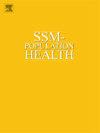Association between stock market volatility and severe mental disorders: a multi-city time-series study
IF 3.1
2区 医学
Q1 PUBLIC, ENVIRONMENTAL & OCCUPATIONAL HEALTH
引用次数: 0
Abstract
Background
Stock market volatility was commonly considered as a psychological stressor. However, the association between stock market volatility and severe mental disorders (SMD) has not been investigated.
Methods
Daily numbers of SMD hospital admissions and Shanghai Stock Exchange Composite (SSEC) Index in 7 cities in southwestern China from 2020 to 2023 were collected. A two-stage time-series analysis was conducted to reveal the association between stock volatility and the risk of hospital admission for SMD. Stratified analyses were performed by age, gender, and ICD-10 codes to explore potential high-risk groups.
Results
The association between the SSEC percentage change, SSEC closing price and SMD hospital admissions both exhibit a U-shaped curve. A 1 % decrease in SSEC is associated with a 7.2 % (95 %CI: 4.1 %–10.4 %) increase in the SMD admission, while a 1 % increase in SSEC is associated with a 2.6 % (95 %CI: 0.1 %–5.2 %) increase in the SMD admissions. With 3400 points as the dividing point, every 10-point increase in SSEC closing price is associated with a 9 % (95 %CI: 3.6 %–14.7 %) increase in the SMD hospital admissions, while each 10-point decrease is associated with a 4.4 % (95 %CI: 0.6 %–8.3 %) increase in the SMD hospital admissions. Furthermore, these associations tended to be stronger in the female and non-schizophrenia patients.
Conclusion
These associations indicate that both rise and fall in stock prices increase the risk of SMD. This finding suggests that it is an effective way to take the stock speculation behavior into consideration when managing and treating the SMD patients.
股票市场波动与严重精神障碍之间的关系:多城市时间序列研究
背景股市波动通常被认为是一种心理压力源。方法收集了中国西南部 7 个城市 2020 年至 2023 年因严重精神障碍(SMD)入院的每日人数和上海证券交易所综合指数(SSEC)。为了揭示股票波动与 SMD 住院风险之间的关系,我们进行了两阶段时间序列分析。结果SSEC百分比变化、SSEC收盘价与SMD入院风险之间的关系均呈现U形曲线。SSEC 下降 1%,SMD 住院率上升 7.2%(95%CI:4.1%-10.4%),而 SSEC 上升 1%,SMD 住院率上升 2.6%(95%CI:0.1%-5.2%)。以 3400 点为分界点,上证指数收盘价每上升 10 点,法定最低入院人数就会增加 9%(95%CI:3.6%-14.7%),而每下降 10 点,法定最低入院人数就会增加 4.4%(95%CI:0.6%-8.3%)。此外,这些关联在女性和非精神分裂症患者中更为明显。这一发现表明,在管理和治疗 SMD 患者时,考虑股票投机行为是一种有效的方法。
本文章由计算机程序翻译,如有差异,请以英文原文为准。
求助全文
约1分钟内获得全文
求助全文
来源期刊

Ssm-Population Health
PUBLIC, ENVIRONMENTAL & OCCUPATIONAL HEALTH-
CiteScore
6.50
自引率
2.10%
发文量
298
审稿时长
101 days
期刊介绍:
SSM - Population Health. The new online only, open access, peer reviewed journal in all areas relating Social Science research to population health. SSM - Population Health shares the same Editors-in Chief and general approach to manuscripts as its sister journal, Social Science & Medicine. The journal takes a broad approach to the field especially welcoming interdisciplinary papers from across the Social Sciences and allied areas. SSM - Population Health offers an alternative outlet for work which might not be considered, or is classed as ''out of scope'' elsewhere, and prioritizes fast peer review and publication to the benefit of authors and readers. The journal welcomes all types of paper from traditional primary research articles, replication studies, short communications, methodological studies, instrument validation, opinion pieces, literature reviews, etc. SSM - Population Health also offers the opportunity to publish special issues or sections to reflect current interest and research in topical or developing areas. The journal fully supports authors wanting to present their research in an innovative fashion though the use of multimedia formats.
 求助内容:
求助内容: 应助结果提醒方式:
应助结果提醒方式:


